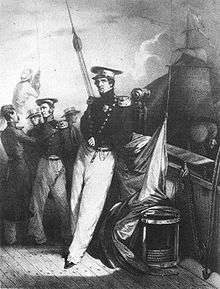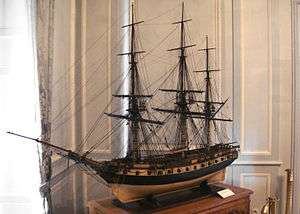Hyacinthe de Bougainville
Hyacinthe Yves Philippe Potentien, baron de Bougainville (26 December 1781 – 18 October 1846) was a French naval officer. He was the son of Louis-Antoine de Bougainville.[1] He became Rear-Admiral on 1 May 1838.
Hyacinthe de Bougainville | |
|---|---|
 Hyacinthe de Bougainville | |
| Born | 26 December 1781 Brest, France |
| Died | 18 October 1846 (aged 64) Paris, France |
| Allegiance | |
| Service/ | French Navy |
| Rank | Rear Admiral |
Career
As a young second-class midshipman of eighteen Hyacinthe de Bougainville participated in the 1800-02 Baudin expedition to Australia.[2]
Hyacinthe de Bougainville sailed around the world from 1824 to 1826 onboard Thétis and Espérance,[1] sent by the Minister of the Navy and the Colonies, the duc de Clermont-Tonnerre.[3]

On 12 January 1825, Hyacinthe de Bougainville led an embassy to Vietnam with Captain Courson de la Ville-Hélio, arriving in Da Nang, with the warships Thétis and Espérance.[4] Although they had numerous presents for the Emperor, and a 28 January 1824 letter from Louis XVIII, the ambassadors could not obtain an audience from Minh Mạng.[5] Hyacinthe de Bougainville infiltrated Father Regéreau from the Thétis when it was anchored in Da Nang, triggering edicts of persecution against Christianity by Minh Mạng.[6]
Bougainville visited New South Wales in 1825. That same year, he visited Port Jackson[7] and Sydney where he set up a monument to La Pérouse and erected a grave for le Receveur in Botany Bay.[8][9] He became acquainted with the leading colonial Sydney figures of the day including John Piper, Samuel Marsden, John Macarthur, and John Blaxland. The daughter of the latter, Harriot Blaxland Ritchie, became romantically involved with Bougainville.
Works
Journal de la Navigation Autour Du Globe de la Frégate Thétis et de la Corvette L'Espérance (Paris : Arthus Bertrand) 1837.
See also
- France-Vietnam relations
- European and American voyages of scientific exploration
Notes
- Randier, p.292
- Horner, F. The French Reconnaissance: Baudin in Australia 1801—1803, Melbourne University Press, Melbourne, 1987 ISBN 0-522-84339-5.
- Colin L. Dyer, The French Explorers and the Aboriginal Australians 1772-1839 p.12
- Oscar Chapuis, A History of Vietnam: From Hong Bang to Tu Duc p. 190.
- Oscar Chapuis, The Last Emperors of Vietnam p.4
- The Vietnamese Response to French Intervention, 1862-1874 p.27
- Colin L. Dyer, The French Explorers and the Aboriginal Australians 1772-1839: 1772-1839 p. 11
- "FURTHER DOCUMENTARY INTELLIGENCE, RECEIVED WITHIN THE LAST WEEK". The Sydney Gazette and New South Wales Advertiser. XXIII (1138). New South Wales, Australia. 8 September 1825. p. 3 – via National Library of Australia.
Oxley, John (1825), Plan of the two allotments of ground, on the North Shore of Botany Bay, released by His Excellency Sir Thomas Brisbane K.C.B., etc.etc.etc. to Monr. Le Baron de Bougainville commanding His Most Christian Majesty's Ship Thesis, for the purpose of erecting monuments to the memory of Count De La Perouse & Father Le Receveur - Maria Nugent (2005). Botany Bay: Where Histories Meet. p. 101. ISBN 978-1-74114-575-5.
References
- Randier, Jean 2006 La Royale Editions Babouji ISBN 2-35261-022-2